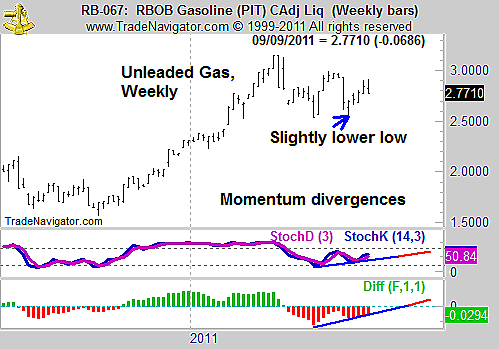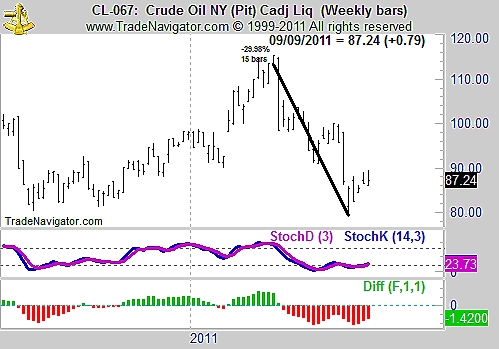
HOT TOPICS LIST
- MACD
- Fibonacci
- RSI
- Gann
- ADXR
- Stochastics
- Volume
- Triangles
- Futures
- Cycles
- Volatility
- ZIGZAG
- MESA
- Retracement
- Aroon
INDICATORS LIST
LIST OF TOPICS
PRINT THIS ARTICLE
by Mike Carr, CMT
Momentum is signaling higher pump prices as technical analysis points to slow, if any, economic growth.
Position: Buy
Mike Carr, CMT
Mike Carr, CMT, is a member of the Market Technicians Association, and editor of the MTA's newsletter, Technically Speaking. He is also the author of "Smarter Investing in Any Economy: The Definitive Guide to Relative Strength Investing," and "Conquering the Divide: How to Use Economic Indicators to Catch Stock Market Trends."
PRINT THIS ARTICLE
STOCHASTICS
Gasoline Futures Still Showing Pain Ahead For Consumers
09/12/11 11:11:55 AMby Mike Carr, CMT
Momentum is signaling higher pump prices as technical analysis points to slow, if any, economic growth.
Position: Buy
| Charles Henry Dow was looking for a way to forecast economic trends when he devised the Dow Jones averages. He was the first to recognize the relationship and observed that stocks turn ahead of the economy. Dow died very young, early in the 20th century. He undoubtedly would have identified other relationships and techniques to monitor the trends. |
| One relationship that seems to be worth paying attention to is the price of gasoline, which has an impact on both consumer finances and consumer sentiment. Prices rose sharply early in the year, but news coverage of fuel prices seems to have been replaced by stubbornly high unemployment. That doesn't mean that the price of gas is no longer a concern. Figure 1 shows that prices are still near the high seen in May. |

|
| FIGURE 1: PIT, WEEKLY. The weekly chart of gasoline futures show that prices have found support at a relatively high level. |
| Graphic provided by: Trade Navigator. |
| |
| Prices have found support twice near $2.50. The second test of that level was accompanied by slight momentum divergences in both the stochastics and moving average convergence/divergence (MACD) on the weekly chart. With futures at almost $2.80, a national average price of unleaded gas near $3.50 will most likely contribute to continued slow economic growth. |
| Crude oil, on the other hand, is significantly lower than it was early this year. Crude tends to rise sharply before the economy slows. This was identified about 20 years ago by John Murphy in his classic work "Intermarket Technical Analysis." Demand is highly correlated with industrial activity. Rapidly declining prices tend to confirm the economic slowdown, and the decline of nearly 30% from the April highs is following that pattern. See Figure 2. |

|
| FIGURE 2: PIT, WEEKLY. Crude oil futures are offering mixed signals with a small divergence in stochsatics unconfirmed by the MACD. |
| Graphic provided by: Trade Navigator. |
| |
| Charles Dow recognized the important connection between markets and the economy in the late 19th century. Those links still exist in current markets and the signals now do not favor a strong economy. Higher gas prices and lower demand for oil present trading opportunities, but also point to the fact that we should closely watch the Fed, which might soon act to boost growth. |
Mike Carr, CMT, is a member of the Market Technicians Association, and editor of the MTA's newsletter, Technically Speaking. He is also the author of "Smarter Investing in Any Economy: The Definitive Guide to Relative Strength Investing," and "Conquering the Divide: How to Use Economic Indicators to Catch Stock Market Trends."
| Website: | www.moneynews.com/blogs/MichaelCarr/id-73 |
| E-mail address: | marketstrategist@gmail.com |
Click here for more information about our publications!
Comments

Request Information From Our Sponsors
- StockCharts.com, Inc.
- Candle Patterns
- Candlestick Charting Explained
- Intermarket Technical Analysis
- John Murphy on Chart Analysis
- John Murphy's Chart Pattern Recognition
- John Murphy's Market Message
- MurphyExplainsMarketAnalysis-Intermarket Analysis
- MurphyExplainsMarketAnalysis-Visual Analysis
- StockCharts.com
- Technical Analysis of the Financial Markets
- The Visual Investor
- VectorVest, Inc.
- Executive Premier Workshop
- One-Day Options Course
- OptionsPro
- Retirement Income Workshop
- Sure-Fire Trading Systems (VectorVest, Inc.)
- Trading as a Business Workshop
- VectorVest 7 EOD
- VectorVest 7 RealTime/IntraDay
- VectorVest AutoTester
- VectorVest Educational Services
- VectorVest OnLine
- VectorVest Options Analyzer
- VectorVest ProGraphics v6.0
- VectorVest ProTrader 7
- VectorVest RealTime Derby Tool
- VectorVest Simulator
- VectorVest Variator
- VectorVest Watchdog
